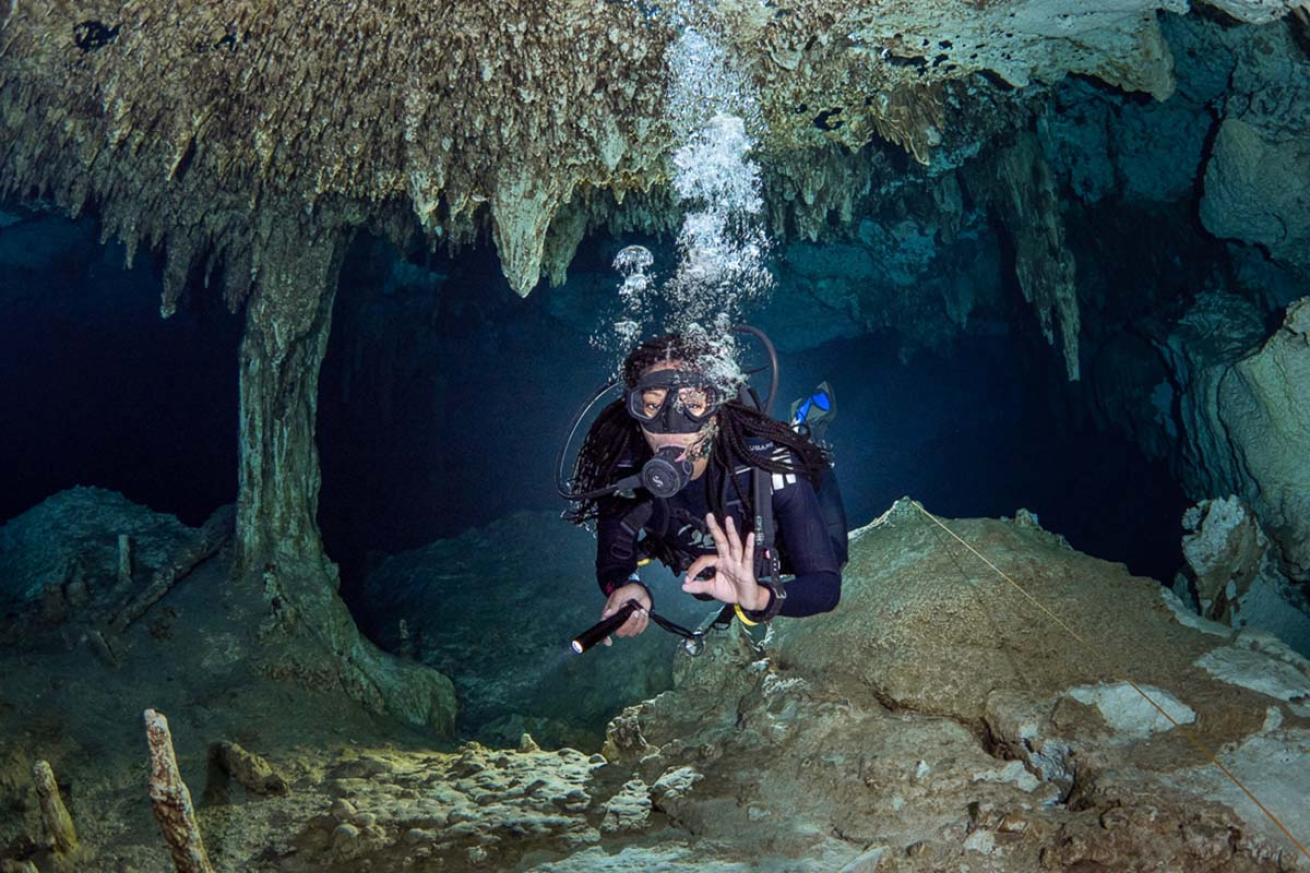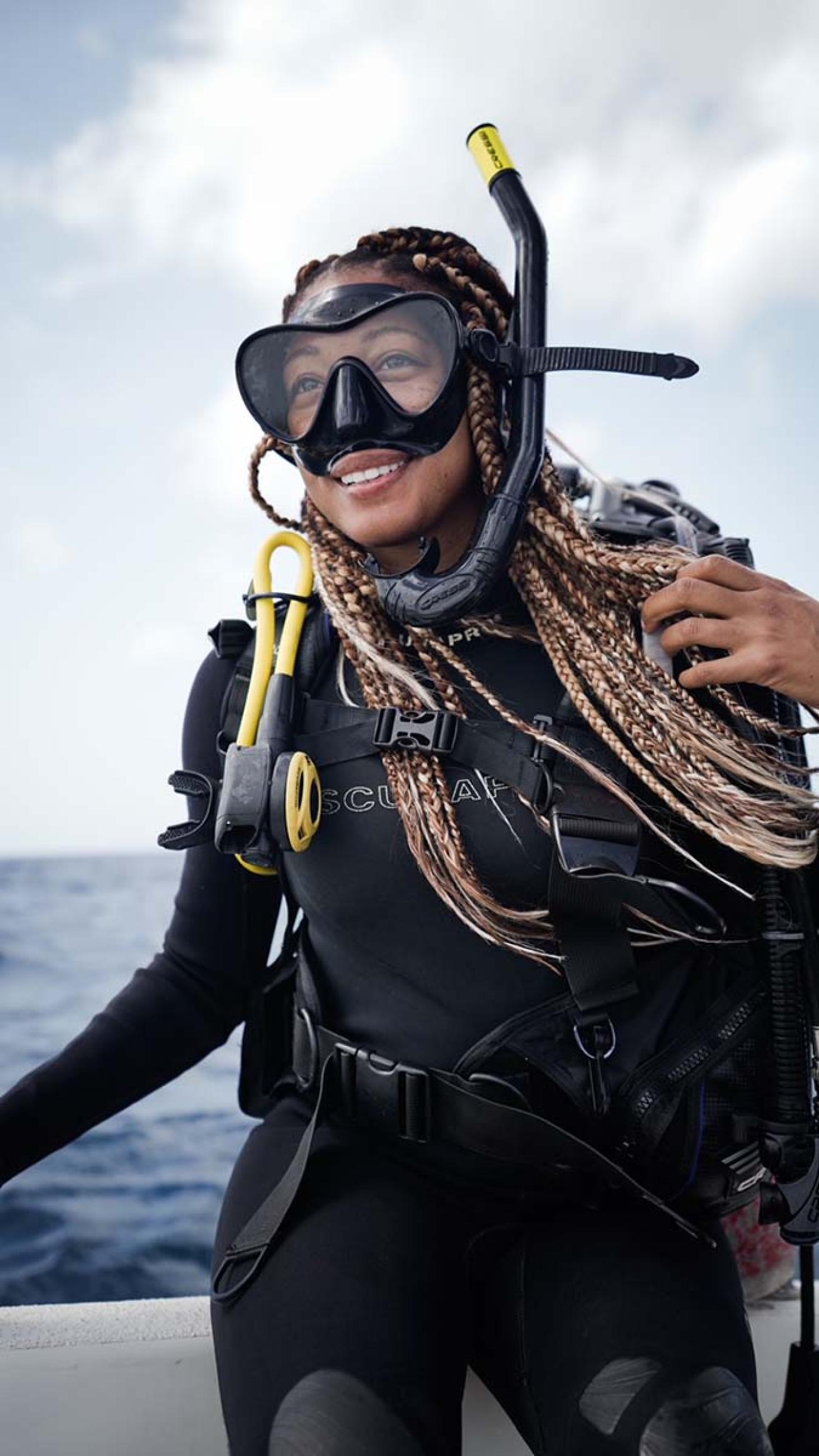Groups and Getaways that Support Diving Diversity

Tom St. GeorgeJordan explores a cenote.
I’ve run half marathons in Philadelphia and Washington DC; hiked the sweeping landscapes of Patagonia, Chile; road biked through the countryside of Myanmar; cruised through the Arctic Circle in Norway. But no experience has touched me quite like dipping into the deep blue—seeing the oddly colored shrimp underwater in Fujairah; the overwhelming abundance of fan corals that blanket Tela, Honduras; diving the UAE and through the cenotes of Tulum were some of my most impactful dives. As a black diver, it is my mission to encourage and inspire people of color to suit up, to explore the world’s diverse underwater gems and witness human’s impact on them, from coral bleaching to plastic pollution.
I am the only black female diver on most of my recreational dives. As a people person, that doesn’t make me feel uncomfortable — divers are all there to support each other and have fun other under the sea and topside — but it would be encouraging to see more people of color experience the wonder of diving. Nothing compares to seeing the silhouette of a nurse shark looking for its next prey, the slow movements of rugged sea cucumbers on the ocean floor, the changing colors of a fast-moving octopus underwater. Based on my diving experiences, the following destinations and organizations support diverse dive communities.
Getaway of Choice: The Caribbean
Being a black diver isn’t as notable in the Caribbean, where I have travelled extensively, as local PADI-certified dive instructors of African origin are widespread. “We can increase diversity by empowering divers and also supporting each other through constant conversations,” says Elijah Jean-Baptiste, a PADI dive instructor based in St. Lucia. “We should cultivate awareness, ensure there is equality and be inclusive.”
Most of the instructors are black when I have stayed at Caribbean Sandals Resorts, including Bimini, St. Lucia, Grenada and Jamaica, where diving is included in your nightly rate.
“At Sandals Resorts, our most predominant client profile has been women ages 35 to 55 and over who are the decision-makers and influencers in their households,” says Michael Clarke, Sandals Resorts International’s Group Watersports Director. “With this in mind, we began supporting PADI’s Annual Women’s Dive Day in collaboration with our Sandals Foundation, which has helped bring awareness to the destination’s marine life and controlled current invasive species, and we work closely with the local Ministry of Environment on over-fishing, coral reef restoration and more.”
Great Groups
Stateside, one way to delve deeply into the powerful stories of African Americans is uncovering the history of the transatlantic slave trade with Diving With A Purpose (DWP), an organization that documents the submerged heritage of slave ship wrecks.

Nico MarinJordan prepares for a dive.
“The first time I dived a slave ship was the Henrietta Marie that ran aground off the coast of Florida in 1700,” says Ken Stewart, co-founder of DWP and Scuba Diving’s 2018 Sea Hero of the Year. “I was overwhelmed with emotion: my vivid imagination allowed me to feel the souls of the Africans that were on board on its journey to the Americas. Prior to 2003, I really had no clue about archaeology, anthropology and was not well versed in the slave trade. Like most Americans-and particularly African Americans-we don't learn it in school and unless you have a strong historical connection, it's not taught in the home.”
One of the most prominent and probable to find slave shipwrecks that they have been searching for during the last 16 years is the Guerrero, a Spanish slave ship that sunk in Florida’s Biscayne National Park in 1827. Through Stewart’s youth division of DWP, Youth Diving With A Purpose, young adults between the ages of 16 through 23 have been able to get involved in the search for the Guerrero.
The Slave Wrecks Project (SWP), run by the Smithsonian in partnership with DWP, focuses on wreck sites in North America, Mozambique, Senegal, St. Croix, among other global locations. In 2014 it recovered the wreck of the slave ship São José and participated the 2019 location of Clotilda, known as America’s last slave ship, in Alabama’s Mobile Bay. Visitors to the National Museum of African American History and Culture can see a permanent exhibit of the SWP with visual imagery and their projects depicted.
Black divers looking to connect with others can join the National Association of Black Scuba Divers, which seeks to “unite black scuba divers through education, dive safety, and scuba diving trips.” There are more than 3,000 members spread throughout chapters in many major cities, including one in my area of New York City called the Aquatic Voyagers Scuba Club.
Another group to have on your radar is Diversity in Aquatics. Its Scuba Council, chaired by Scuba Diving 2021 Sea Hero of the Year Anesti Vega, is currently accepting applications from divers of color for its scuba certification scholarship. The first class of recipients will be announced in February 2022.
Finally, online, recent Black Out Tuesday and Black Lives Matter movements have propelled many influencers to showcase black content creators. Girls That Scuba has been particularly vocal and supportive on its Instagram account and Facebook group, and I find it comforting to know that there is a community that supports female divers of all backgrounds.










